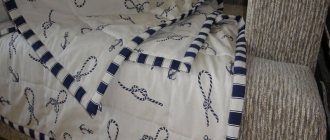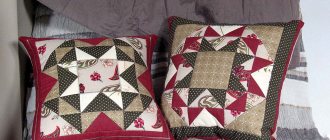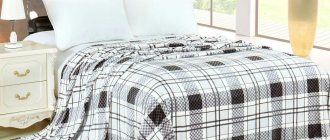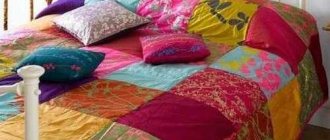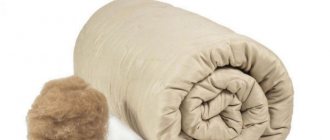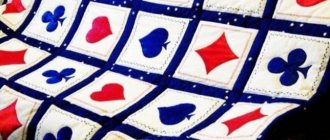The tradition of using any scrap arose a long time ago, when people still sewed clothes and furnishings themselves. Everything in the houses was done and decorated with one’s own hands. Today, the technique of sewing from scraps is experiencing a new round of popularity, however, as an opportunity to make an unusual item for the home that will express taste and talent for both professional craftswomen and beginners. A master class on a patchwork quilt will interest many.
DIY patchwork blanket made from squares
For sewing you will need:
- squares of cotton fabrics, different colors, 25 cm by 25 cm – 20 pcs.;
- padding or fleece - 105 cm by 130 cm;
- fabric for the wrong side – 105 cm by 130 cm;
- threads, sewing tools.
How to sew a blanket
To sew a patchwork quilt with your own hands, we prepare the required number of square patches.
Then we lay out 4 squares. for 5 pieces, combining them by color.
Let's start sewing a blanket from multi-colored scraps with our own hands by making horizontal stripes. To do this, fold the squares in pairs with their right sides facing each other. First we will sew the sides of each pair on the right side of the stack, then we will have to sew the squares on the other side.
We continue patchwork sewing by stitching together the finished strips. One common part is sewn from them. The technique for assembling a patchwork quilt is as follows: fold the strips right sides together, pin them together, paying attention to the coincidence of the lines of the transverse stitching seams.
We combine the stripes into a common fabric.
Iron all seams.
From the sealant we cut out a rectangular piece, equal in size to the patchwork piece. We place the seal on a horizontal, flat surface, and place the patchwork piece on top, face up.
We cut out the blank for the bottom part of the bedspread and place it on the laid out parts of the seal and top, face down. We chop off a three-layer “sandwich” and stitch it, leaving an open area.
Trim off the excess seam allowance and turn it inside out.
Carefully straighten the seams, paying special attention to the corners, and iron the product. In this case, we turn the allowances in the open area inward. We sew up the open area using a machine, although you can sew it manually with blind stitches.
The blanket is voluminous and warm. Given the multi-layer nature, it is recommended to quilt all patchwork bedspreads. Let's do this with a regular simple line. We perform it in the seams of sewing flaps.
The voluminous bedspread is ready!
Tools and materials
For sewing we will need:
- sewing machine (or needle and thread);
- scraps of different colors for the top of the blanket;
- a piece of fabric for the wrong side;
- material for insulating gasket;
- ruler, square.;
- templates;
- scissors;
- iron;
- colored pencils or markers;
- threads;
- needles, pins;
- scotch.
You can sew without a machine, by hand, as our grandmothers and great-grandmothers did. Of course, it will take more time, but the result will be no worse. In some cases, hand sewing looks neater.
DIY patchwork bedspread
To sew a patchwork bedspread you will need:
- multi-colored rags 6.25 cm by 11.25 cm – 160 pcs.;
- two pieces of plain fabric (light and dark) – 120 cm;
- fabric for border – 45 cm;
- batting or other insulation 1.3 m by 1.4 m;
- fabric for lining – 1.3 m by 1.4 m;
- threads, sewing tools.
Step-by-step sewing instructions and photo master class
To make a blanket from multi-colored rags with your own hands, cut a light plain fabric into nine strips 6.25 cm wide. Then we divide each strip into rags 11.25 cm long. A total of 80 light rags are needed.
Using a similar technology, we cut dark fabric, obtaining 80 flaps measuring 6.25 cm by 11.25 cm.
For the border we prepare 5 strips of 5.6 cm each.
We fold the printed and plain flaps in pairs with their front sides facing each other, and sew them along the long sides. We get square blanks 11.25 cm by 11.25 cm, since part of the double width will go to seam allowances.
We lay out the blanks, orienting their seams perpendicular to each other.
When making a patchwork mosaic strip, we alternate two blanks with a light border with two blanks with a dark one. Each strip must consist of 12 squares.
When combining the flaps for the second strip, we lay the first square so that its stitching seam is perpendicular to the stitching seam of the first square of the first strip - see photo.
A completely hand-made patchwork blanket consists of 13 stripes, 12 squares each.
To ensure that a hand-sewn patchwork blanket is not only beautiful, but also warm, we use a batting pad.
We lay the material for the lining on the floor with the wrong side up, put insulation on top, and place the patchwork piece on top of it with the right side up. We cut off three layers.
We quilt the bedspread using any type of stitch.
For the border, we sew strips 5.6 cm wide into one piece and press the seams. Fold the border in half, inside out, and iron. Then we fold the cuts of both sides towards the center and iron them.
We trim the sections of the bedspread, cutting off irregularities and excess insulation. We process the perimeter of the bedspread with a border.
Blanket made from old sweaters with individual parts knitted
To sew a blanket with binding you will need:
- old sweaters;
- Knitting thread;
- hook and scissors.
We rip the sweater and give its fragments (sleeves, back, front) a rectangular shape
We cut the prepared material into squares or rectangles. We lay out the resulting blanks, forming them into a blanket (it’s better to do this on the floor).
We crochet the resulting shred in a circle, the first row with a single crochet
The second and subsequent rows are double crochet, we knit an arbitrary number of rows for our fragment of a blanket
We take one flap and tie it in a circle, crocheting on all sides, adjust the number of rows of tying at your discretion.
We connect the resulting fragments together with a single crochet stitch.
We do this with each element of the blanket. We tie together the parts of the blanket with a single crochet.
Having made the required number of “sweater patches”, we connect them all together with a single crochet
The finished fabric for our blanket, if desired, you can make it double-sided or with a lining
A cozy warm blanket looks great on the sofa
Children's patchwork quilt with trapunto embroidery
Dimensions of the finished product are 125 x 125 cm.
What you need to prepare:
- dark fabric with a small print, with a width of 1.1 m you need to take 0.5 m;
- the fabric is light, plain, with a width of 1.1 m you need to take 0.5 m;
- fabric that combines the color scheme with the previous ones, with a “peas” pattern, with a width of 1.1 m you need to take 0.7 m;
- fabric that matches the color of the underside of the blanket;
- fabric for bias tape or finished tape;
- filler;
- threads, sewing tools.
How to sew a patchwork quilt
We sew a patchwork quilt from square blocks, sewn, in turn, from rectangular and square parts.
We will combine the patchwork components according to the Irish square pattern. It is practical and versatile, easily converted to the required size of the blanket. A chain made up of squares can be single, double or triple. It depends on your choice. Embroidery or applique will look great on free areas.
The composition of the Irish square is harmoniously combined with other types of patchwork techniques and is easy to implement. This is an ideal option for beginners.
This blanket does not require a duvet cover; it can be used as a bedspread.
For convenience, the fabrics used in cutting are indicated in the photo with letters.
We cut strips of four types of fabric in width:
- plain (C) – eight stripes 16.5 cm by 27 cm;
- polka dots (B) – five stripes 16.5 cm by 27 cm;
- The rest of the fabric is cut into strips 6 cm wide.
Each block is a square with a side of 20 cm. It includes five strips of squares with a side of 5 cm. Seam allowances must be added to this size. When using a quilting foot, an allowance of 7-8 mm per side is sufficient. Accordingly, the side size of the square workpiece is 6.5 cm.
We sew the strips in the sequence C – A – B – A – C.
Then from the sewn wide strip we cut strips 6.5 cm wide.
Sew the cut out strips so that the dark squares are arranged in a checkerboard pattern.
We must prepare 12 identical square blocks.
The second type of square blocks is sewn from fabrics A and B. From fabric B, we cut out one rectangle 15 cm by 25 cm, two rectangles 5 cm by 15 cm. From fabric A we prepare four squares with a side of 5 cm. Do not forget to add seam allowances 7-8 mm each. Sew the squares together as shown in the photo.
Similar blocks in the amount of 8 pcs. sew from fabrics B and C.
We make four more blocks from fabrics A and B, almost as described above, but we place dark squares only in three corners of the element.
From the prepared square blocks we assemble the upper part of the bedspread, guided by the photo. First we connect the horizontal stripes, then we sew them vertically.
How to do embroidery
This master class uses two patterns made with straight stitches. Such patterns are best suited for embroidery using the trapunto technique. This is voluminous embroidery that requires certain skills. For craftswomen who have not previously encountered this type of needlework, it is advisable to study it first.
To complete the work, in addition to the stitched patchwork fabric, we will need a sealant and a tear-off non-adhesive stabilizer.
On each square block where embroidery will be done, we find the center point. We thread the tear-off non-adhesive stabilizer into the hoop and apply a layer of glue to it. If your cushioning layer is made of fleecy fabric, then there is no need to apply a layer of glue.
We glue the cushioning material onto the stabilizer and place a square patchwork block on top of it. In this case, it is important to orient the area for embroidery in the center of the hoop.
We fix the patchwork square with pins. Embroider the selected fragment. We embroider similarly on the remaining patchwork blocks.
Assembly
Carefully trim the filling around the embroidered fragments at a distance of 5 mm from the seam. We pin together the layers of the blanket with pins. We sew the blanket using a walking foot along the perimeter and diagonally.
Free motion stitch
We quilt the squares with central fragments of fabric B using a free-running stitch, making a “brains” pattern. You can also hand stitch along the contour of the embroidery at a distance of 5 mm from it. If you want to add extra volume to your embroidery, use microstitching.
Processing the edges of the bedspread
We prepare the bias tape and process the edge of the product either by machine or by hand.
The bedspread is ready!


